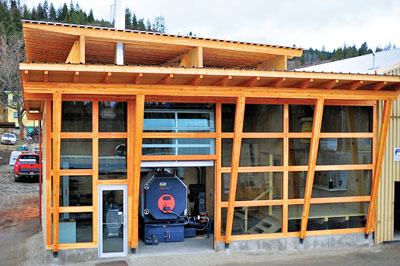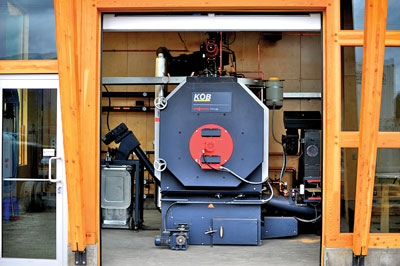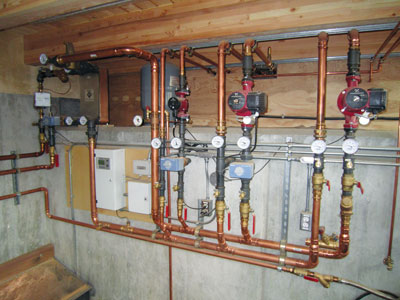
Biomass Benchmark
October 16, 2012
By
John Tenpenny
When implementing a district energy system, speed is not always the first thing you think of.
When implementing a district energy system, speed is not always the first thing you think of. Add in biomass and some people become even more skeptical about undertaking such a project. But in the case of Fink District Energy in the Okanagan in British Columbia, the reality was quite different.
 |
|
| The Fink Enderby District Energy project includes a custom-built boiler house with wood chip fuel storage bunker and walking floor feed system. Photos by Carrie Bearss/Imedge Photography
|
After Burkhard Fink, founder and owner of Fink Machine Inc. in Enderby, B.C., got the go ahead in 2011 from the city to implement the first privately-funded biomass district energy system in western Canada, only eight months passed between groundbreaking and the system becoming operational.
Stephen Bearss, a renewable energy representative with Fink Machine, calls it a “benchmarking system. “Some people, especially when they hear biomass and district energy, think it can be a long and drawn out process because of the technology, but the reality is when everyone is on board, the systems themselves can actually go together relatively quickly,” he says. “It’s a cost incentive from a construction standpoint that it doesn’t take two years to build.”
Fink Enderby District Energy is the first privately-funded biomass district energy system operating as a Private Utility under 1 MW in western Canada (it is registered with the British Columbia Utilities Commission). The district system currently serves eight commercial, institutional and residential customers, including the local Lions Pool, which was the first building connected to the system and Fink Machine building. Three more customers will be online by the spring of 2013, while there remains capacity for future growth. (The hotel is currently only using domestic hot water, but they intend to add space heating in the near future.)
Boiler power
A KOB Viessmann Pyrot 540 wood-fired boiler (rated at 540 kW) is the primary source of space heating, domestic hot water and pool heating for district customers. The fully-automatic Pyrot utilizes the an advanced combustion technology, triple-pass heat exchanger and modulating output control to achieve an efficiency of 85 percent while keeping emissions to a minimum. Continuous gasification is carried out on the moving grate with minimal primary air. The combustible gases rise into the rotary combustion chamber and are mixed with secondary air that had been diffused by the rotation blower and given spin impulse. This guarantees a perfect mixture of secondary air with the combustible gases.
 |
|
| The system’s primary source of space heating is a Viessmann Pyrot KRT-540 wood-fired boiler (rated at 540 kW). |
A monitoring system and safety equipment ensure safe and reliable operation, while a 300 kW gas-fired boiler provides backup and additional capacity during peak loads, which Bearss says hasn’t happened yet. The district lines are made by Urecon and installed by Fink Machine Inc., while Ocana Construction of Armstrong, B.C., poured the concrete foundations.
A timberframe energy centre, constructed by Fink Machine Inc., includes a district fuel bunker with a capacity of 50 tonnes, which allows two 53-foot trailers to unload and depart. (The building’s laminate beams were supplied by Structurlam Products of Penticton, B.C.) An auto-mated walking floor delivers fuel from the storage bunker to the Pyrot’s feed auger. When fuel gasification and combustion are complete, an automated deashing system extracts ashes from the combustion chamber and transfers them to an ash bin. An ash removal auger extracts the ashes into a large external container once they have cooled.
The Pyrot boiler feeds an 8,400 L water buffer tank before distributing heated water to transfer stations and customers through a 640-metre main line consisting of three-inch insulated Urecon PEX pipe.
Homegrown fuel
Fink Enderby District Energy’s carbon neutral wood biomass fuel is supplied by local sawmills and wood product manufacturers, including a window shim plant. It also receives pulp chip screenings from a mill in Revelstoke. Bearss says their fuel costs average $25-50 per tonne. Wood waste is also being diverted from landfills and businesses within a two-hour transportation radius.
According to Bearss, area landfills are now having to seriously look at modifying their material recycling facilities to create wood biomass fuel or run out of landfill.
“We’re working with the City of Vernon’s landfill trying to get them to streamline their wood waste stream by clean wood, like pallets and construction demolition debris, and sorting and separating the nails and anything that’s not wood biomass out of that steam so we can use it in our boiler.”
He says that Fink is hoping the city will move ahead and order the proper material recycling equipment to sort and separate out the waste that isn’t wood. It would be a prime use of wood biomass in the local area and it may be something that [the City of Vernon] will actually pay Fink Enderby District Energy to take potentially, because “for them it’s a necessity to make space.”
The system is expected to consume 800 tonnes of renewable wood fuel annually while helping to mitigate approximately 425 tonnes of greenhouse gases.
Interested Parties
Users are reporting savings of 10 to 18 percent just on efficiency improvements over their old systems compared to the energy transfers they’re getting from the district energy line now, says Bearss.
 |
|
| A custom boiler control and pump system manages efficient heat production and distribution for the energy system.
|
This has created some interest both from local business joining the system and other communities looking at implementing their own district energy system.
“What we’re finding is that people before that weren’t interested for whatever reason, now realize from talking to their neighbours that are on the district energy grid and learning about its advantages and are wanting to learn more about getting on board themselves,” says Bearss.
“We have some potential clients that have talked to us about tying into the district energy grid. Hopefully people in the community will become involved and tie into the grid because they find it an advantage to them in many different ways.”
One advantage, Bearss points out, is operational maintenance because continual maintenance is no longer required on previously installed boiler or heating systems and they can then become a back-up or stand-by.
“[The energy district system] is set it up so that it’s a cost-savings advantage for people to do business with us,” adds Bearss. “Even though it’s small, rural system, it does have the three fundamentals of district energy – space heating, domestic hot water and process heat.”
According to Bearss, the cost to “cookie cutter” this system in a similar install setting is approximately $1.2 million, which he says has caused many in the public sector to rethink their approach because until “our system came online consulting firms were estimating systems similar to ours for communities at nearly seven times the price. Since the beginning of the year this installation has resulted in two communities who have selected Fink Machine to install a similar system in their communities.”
By utilizing biomass fuel, an energy source largely independent of today’s wide energy price fluctuations, says Bearss, Fink Enderby District Energy can provide customers with economical, safe and environmentally responsible heating for years to come.
Print this page